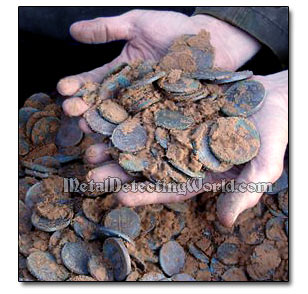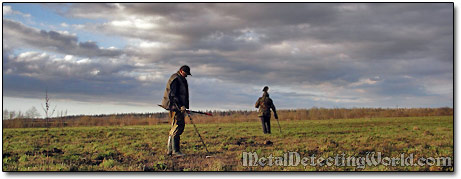Types of Metal Detecting Activities, page 9
COIN CACHE HUNTING Types: Helpful Information, Tips, and Accessories and Metal Detectors Required for Coin Hoard Hunting
by Sergei Upstateny , ; last time modified:
Coin Cache Hunting means searching for hidden caches of coins or coin hoards. Cache hunting includes a few sub-categories defined either by the methods of hiding coin hoards or by their placement locations. Cache hunting also defines searching for other types of amassed valuables buried in one spot (Cache Hunting Types II and III).

During the coin cache burial in the past, amassed coins would be initially put inside the metallic or non-metallic containers which could be:
- 1) buried in the fields or vegetable patches, and under the fence poles,
- 2) buried near static natural or cultural landmarks such as big trees, boulders, earth mounds, bridges, ramparts, etc.,
- 3) hidden in caves, tunnels, and near mine entrances,
- 4) dumped or discarded during an emergency into the rivers, creeks, brooks, ponds, and lakes situated in close proximity to roads and pathways,
- 5) stashed inside the stone walls, wells, outhouses or privies, hen-coops, sheds, barns, or any other structures on the homestead property,
- 6) hidden inside the house: in the walls, under a porch or stoop, under staircases, under flooring, inside furniture, in root cellars, and many other places.
Major Categories of Coin Hoards and Coin/Relic Treasure Caches:
- 1) Expropriatory Cache - a cache of valuables that were taken away from the owner and hidden against the owner's will.
- 2) Returnable Cache - a cache of valuables that were buried with intention of their retrieval in the future.
- 3) Nonreturnable Cache - a cache of cultic treasures that were buried to serve as a sacrifice to gods, therefore, were buried forever.
- 4) Short-Term-Cumulation Cache - a cache of valuables that had been amassed within a short period of time before being buried (small household and personal savings).
- 5) Long-Term-Cumulation Cache - a cache of valuables that had been amassed for a long while before being buried (large savings of prince or duke, monastery, merchant, outlaw, etc.).
- 6) Emergency Cache - a cache of valuables that were buried or hidden during an emergency, in a hurry, and under duress; usually placed into the ragged, casual or any other inappropriate container, or burried without it.
Four Major Types of Cache Hunting:
CACHE HUNTING TYPE I - Searching for Buried Coin Hoards in Plowed Fields
If the site of the former village, homestead or dwelling is currently located in the farmed field that has been PLOWED for many years, and likely to have a few hidden coin hoards, you might find them by means of a conventional land metal detector that is capable of finding ALL types of coins. The search method for this case is the simplest and described in my Tutorial for Recovering a Coin Cache in the Plowed Field.
Though this type of cache hunting does not require a substantial research, it requires a lot of patience and time for scanning large areas in the fields with a metal detector. During the process, 5% of the total time would be spent for research, and the rest 95% would be spent for metal detecting.
Hunting for a Coin Hoard in Farm Field

FAQ's
The following frequently asked questions relate to Coin Cache Hunting of both Type I and Type II (see next page):
1) "Do you agree that former settlements are the best places to search?" - Yes! Any site of former settlement is the first place to search!
2) "What are the chances of discovery of at least one cache comprising more than 10 coins buried at the former small (10 houses max.) settlement site, given that it was never searched by a detectorist? Rather 1% or 10% or maybe 50%?" - 100% if the results of your research show that the settlers had extra money (profits from trade and/or selling agricultural produce, or salaries of soldiers coming back home from wars, etc.) to stash away. Depending on coin denominations, large caches usually contain an amount of coins that can fill up a pail or a medium-sized jug. The small coin caches contain more than 100 coins. Even when it is just a buried purse, there are usually more than 10 coins in it.
3) "Up to what distance from the center of the former village does it make sense to search? Should one search the area where the houses once stood?" - It depends on configuration of a village. In most cases, the coin caches were usually buried behind the houses at the vegetable patches or backyards which may home small sheds and hen-coops - great spots to bury valuables and quickly retrieve them without being seen. For example, take the site of the former linear village in Eastern Europe. If you can determine where the houses used to form a line on one or both sides of the only street in the village, search the area within 50 meters from that line, on one or both sides of it. Searching the area where exactly the houses once stood would require a different approach since it would not be easy to extract a coin cache from underneath a concentrated layer of various iron junk.
4) "Should I search some 300 meters away from the village to get the caches that were hidden in the forest situated nearby? The forest rim is probably a much better place to search, or?" - The caches were buried in the forest positioned some distance away from the village only during the emergency situations (military raids, natural disasters, etc.) when people did not have time to hide their valuables at the property and had to run with everything they could carry to the nearest forest (also hills and mountains). If there are no visible landmarks (large boulders, rock piles, earth mounds, ground depressions, etc.) in this forest, it is almost impossible to locate treasure caches hidden in it. Finding coin caches that are hidden in the hills or mountains may be less challenging.
5) "I think the houses were once framed by arable fields and that there are little chances for cache burials on these fields." - Only if the village was never burnt down or destroyed during its lifetime. In regions ravaged by wars, the case is usually the opposite: a village would be burnt down and later rebuilt at a different location but in the same vicinity. So if the area saw lots of military action in the past, it makes sense to search the adjacent fields for another "village spot" which is more likely to contain a few buried coin hoards. And these coin hoards are the easiest to find (you may want to see the above-mentioned Tutorial on Search and Recovery Method).
6) "Can the plow spread the entire cache so evenly that there is no cache's core left?" - It is usually the opposite, even in cases when the coin caches were initially placed inside the fabric container (pouch, bag, etc.): the cache core - usually 2/3 of the entire cache, remains unbroken by the plow. You determine the core's location by the shape of the "coin scatter" (or the cache's "ploughed-up spot") and then dig a prospecting pit. To get all coins positioned at various depths, you should dig four more pits, one on each side of the first one.
7) "When you remove earth from the prospecting pit, do you take any precautions not to damage the coins with the shovel?" - It is impossible to take any such precautions while extracting zillion of small coins mixed with dirt from the pit. Large coins can be carefully separated from dirt one by one by means of eyeballing or metal detecting during the recovery process, or mass-recovered by means of the ground cloth and a plastic trowel.
8) "If the cache was not inside the hard (iron or ceramic) container, is it correct to say that the cache's core may be roughly a sphere, consisting of coins and earth?" - The core may be of any shape depending on the fabric container's shape. For example, inside a stocking, coins are usually stacked forming a column. And such a cache contains a few coin columns. The cache's core is never a mix of coins and dirt. It consists of only coins that are hard-packed. That is why silver coins sometimes show green (patina) round stains on them when the coin hoard comprises both silver and copper coins. The latter get oxidized and stain the silver coins.
9) "So it should have been possible to detect the cache's core with a deep seeker (Pulse Star II Pro, Lorenz Pulse 5) and the 1m x 1m frame coil, right?" - Theoretically yes, but if there are large iron objects in close proximity, you will have to take them out first in order to eliminate their effect on your detector's electromagnetic field detection pattern (see illustration on "Target Identification Techniques" page). This would require a lot of digging because any former village site contains many large ferrous objects.